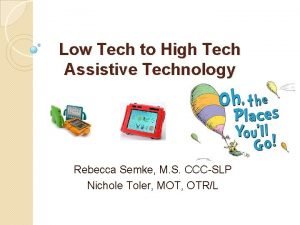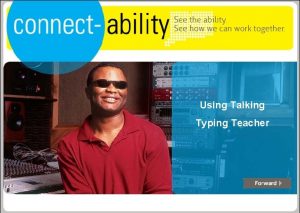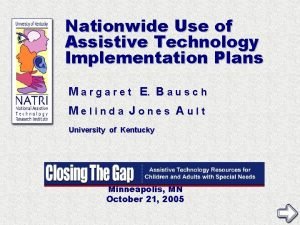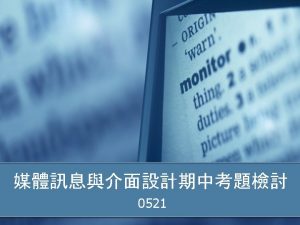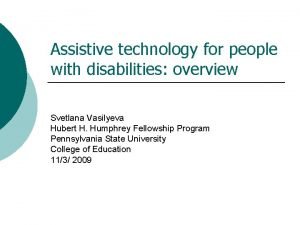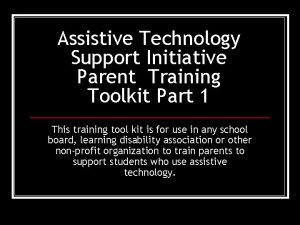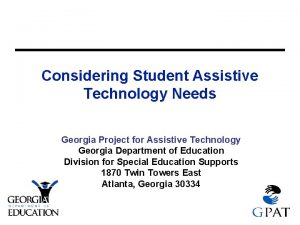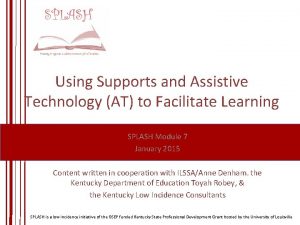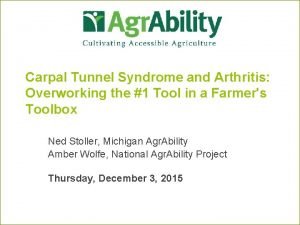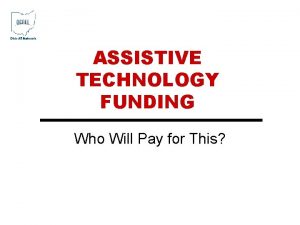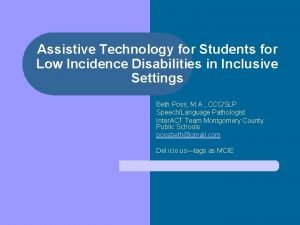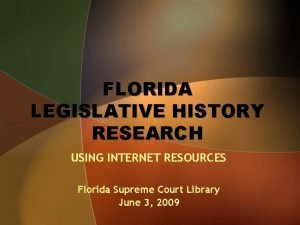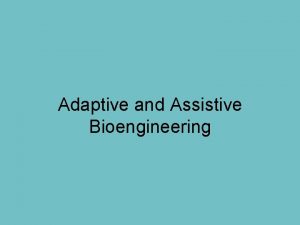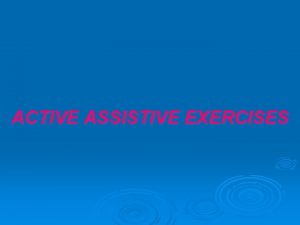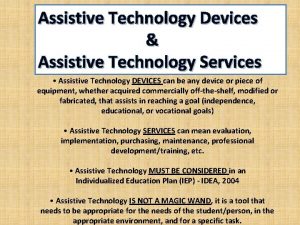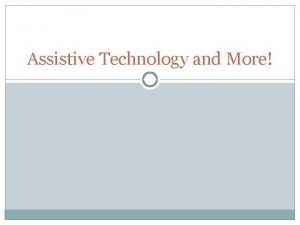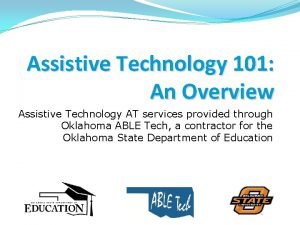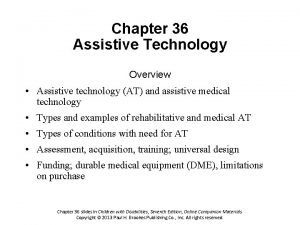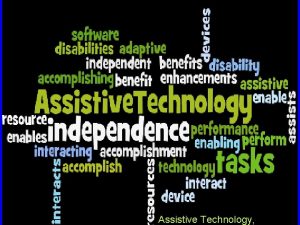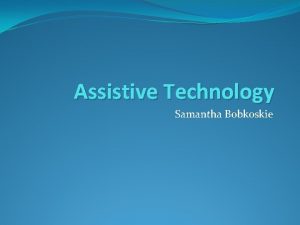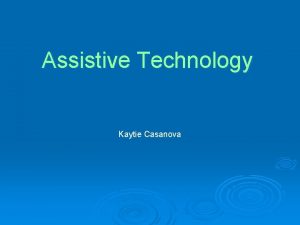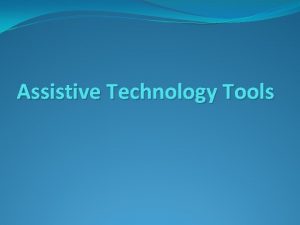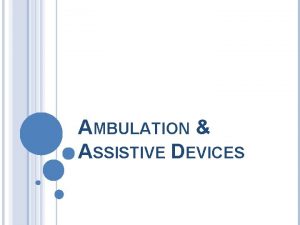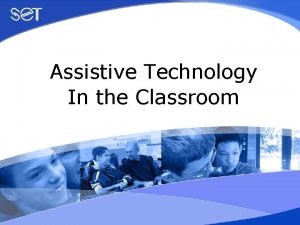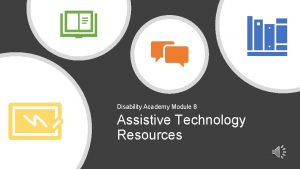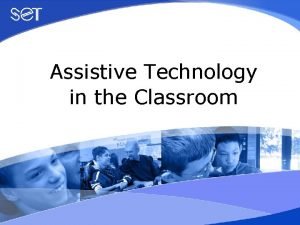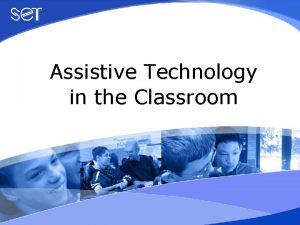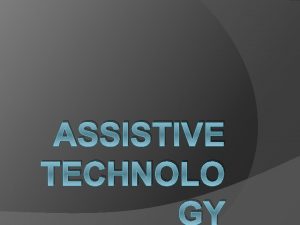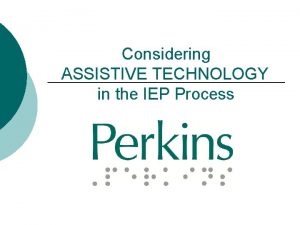The Assistive Technology Act Legislative History and the





















- Slides: 21

The Assistive Technology Act Legislative History and the Basics of the 2004 Law Last updated June 2018

High Level Overview AT Act Legislative History and Current AT Act structure

Legislative History – Titles/Sections 1988 – Title I: Grants to States & Title II: Programs of National Significance 1994 – Both Titles above plus Title III – Alternative Financing Programs 1998 – All three Titles above plus Title IV that repealed the Tech Act 2004 -- Changed from Titles to Sections Section 1. Short Title; Table of Contents Section 2. Findings and purpose Section 3. Definitions Section 4. State grants for assistive technology (activities and formulas for grants) Section 5. State grants for protection and advocacy services (activities and formulas) Section 6. National activities (required and optional grants) Section 7. Administrative provisions Section 8. Authorization of appropriations

State AT Program Funding History Technology Related Assistance Act 1988 * 5 year competitive grants; Staggered state start, ≈ 10 grants per year Technology Related Assistance Act 1994 * Additional 5 years, 10 year total with sunset * Funding increase until year 8, then 75%, then 50%, then sunset Assistive Technology Act of 1998 (3 year extension for max 13 years) * Froze funding at year 10 level, most were at 50% FY 2002 through 2004 appropriation override of sunset – level funding 2004 Reauthorization of Assistive Technology Act – formula grant funding

State AT Program Activity History 1988 - Began with direct service focus (but not direct buy) • • Broad state flexibility to determine activities to implement Significant variability between states in activities and approach State application directed activities NIDRR administering agency 1994 - Refocused on systems change • • Policy improvement and individual advocacy activities required Added Protection & Advocacy mandatory contract Goal to “change systems and build capacity” and be done in 5 years (end funds) Added competitive financial loan grant title (with mandatory 50% state match and limited to one award per grantee under this title)

State AT Program Activity History (cont. ) 1998 – Extension of existing law • Added three years to continue same focus • Appropriations for Title I allocated by percentage • State AT Program Grants (Section 101) – 87. 5% • P&A Grants (Section 102) – 7. 9% (direct grant to P&A, eliminated mandatory contract) • National Technical Assistance Grants (Section 104) – 4. 6% • First competitive funding for Title III AFP in FY 2000 • First year 50% state match, then adjusted via appropriation language to 25% state match and waived limitation of only one award per grantee 2004 – Changed focus to services that “put AT in consumers hands” • • Became formula grant program for State AT Programs and P&As Set of mandatory activities with some flexibility Folded financial loan activities into formula program (no competitive section) RSA became administering agency

AT Act Legislative History since 2004 No reauthorization attempts • Authorization of 2004 law for 5 years • Funding authorization for Sections 4, 5, and 6 continues according to 2004 law provisions until reauthorization 2014 – Workforce Investment and Opportunity Act (WIOA) • • Transferred AT Act administration from ED/RSA to HHS/ACL Section 4 activities administered by Center for Integrated Programs in ACL Section 5 activities administered by Administration on Disabilities in ACL Section 6 national activities administered with Section 4 • except for a portion of general technical assistance grant dollars (Section 6(b)(3)) administered with Section 5

AT Act Funding requirements • Section 4 Formula • 410, 000 State minimum and $125, 000 territory minimum • Base year of FY 2004 grantee award used as start for all calculations, then • Add/subtract 50% equally and 50% based on population until minimums reached • Once minimums are reached, additional allocated 20% equally and 80% based on population • Section 5 Formula • Reservation for American Indian Consortium first, then • Allocated by population with $30, 000 territory and $50, 000 state minimum override • Section 6 – 3 required grants & 2 optional activities authorized • General TA and National Internet Site combined for most recent award • Total allotment about one million for many years

Current Funding of the AT Act • Section 4 – formula grants for Statewide Assistive Technology (AT) • 56 grantees - 50 states, DC and PR (treated as “states”) and 4 territories • FY 18 awards - 4 grantees less than $410, 000 “state” minimum in law 29 “state” grantees less than $500, 000; only 10 “state” grantees over $600, 000 4 territories between $125, 000 (minimum by law) and $127, 000 • Section 5 – formula grants for State Protection & Advocacy AT • 57 grantees, 50 states, DC, Puerto Rico, Native American project and 4 territories • FY 18 - all “state” grantees at $50, 000 minimum; all territory grantees at $30, 000 minimum • Section 6 – required 3 competitive grants for technical assistance • General Technical Assistance and National AT Internet site (now combined into one award) • Data Technical Assistance • Two optional national activity grants have never been funded • National Public Awareness Toolkit • Research and Development

Section 6 Current Implementation • General Technical Assistance (TA) and National Internet Site Grant • ATAP current grantee • Supports Section 4 grantees along with general AT support through national internet site • Transfer of Section 6 general TA dollars to AIDD to support Section 5 TA • Dollars added to existing NDRN contract/agreement(s) for P&A TA • Data Technical Assistance Grant • University of Mass/Institute for Community Inclusion current grantee • Supports Section 4 grantee data reporting and analysis • Partially supports the National AT Act Data System (NATADS) • Day-to-day data system • Aggregate Annual Progress Report (APR) system

Section 4 in Detail

Lead Agency/Implementing Entity Governor appoints a lead agency and, if appropriate, an implementing entity • Lead agency must be a public entity – for FY 17 of 56 grantees • 20 Universities – of those 15 are UCEDDs • 27 VR Agencies • 9 Other State Agencies (Disability, Administrative, Special Education) • Implementing unit (either lead agency or implementing entity) for FY 17 • 14 Non-profit agencies (7 dedicated AT, 2 P&A, 2 IL, 2 Easter Seals, 1 other) • 20 Higher education (15 UCEDDs and 5 other units) • 22 State agencies (14 VR, 8 others - e. g. disability, administration, education, health, DD Council)

Advisory Council Required membership • • 51% individuals with disabilities who use AT or family/guardian Representative from vocational rehabilitation Representative from Blind-VR if separate agency Representative from a state center for independent living Representative from the state workforce investment board Representative from state education agency Other agencies as appropriate Purpose • Provide advice for planning, implementation, and evaluation of activities • Council can be purely advisory or can have higher level of decision-making

Section 4 - State Activities • State Level Activities - required or flexibility/comparability • State Financing – cash loan, other activities directly provide AT or provide savings • Reuse – exchange, refurbish/reassign, open ended loan • Short-term Device Loan – for decision-making, while device is being repaired, waiting for funding, short-term accommodation, or professional development • Device Demonstration – compare features/benefits and determine if appropriate • All were 1998 statute discretionary activities • State Leadership Activities – All required • • Training and Technical Assistance Public Awareness (including information and assistance) Coordination and Collaboration All were 1998 statute required activities

Flexibility & Comparability • Flexibility -- A state may implement only 2 or 3 State Level Activities (instead of all 4) but the allocation changes: • Must allocate at least 70% of grant (instead of 60%) to 2 or 3 state level activities conducted, and • Cannot allocate more than 30% (instead of 40%) for all state leadership activities • Caution if opt out of both access or all acquisition activities - result will be no performance measure data • Comparability -- Programs are not required to use their AT Act grant dollars to perform a state-level activity if in the state: • Other non-federal financial resources support that activity; and • The level of non-federal support is comparable to the amount that would be expended if the state were to use federal funding • Must be able to describe and justify comparability claim

Caveats and Restrictions • Funds shall not be used for direct payment for AT for an individual with a disability. • Federal and State agencies can not reduce assistance or benefits under any federal law as a result of the AT Act. • Funds must supplement not supplant. • Grantee must use 5% of leadership funds to provide transition training and/or technical assistance (in both education and community living areas). • Federal Fiscal Year 2004 Funds may be used for AT Act of 1998 Title III provision.

State Plan (application for funds) • Develop with Advisory Council and stakeholder input • Identify lead agency and implementing entity • Identify state level activities to be implemented • If comparability claimed, provide justification • Comply with required expenditures for state level & leadership activities • Minimum of 60% (or 70% if flexibility claimed) for state level activities • Minimum of 5% of state leadership for mandatory transition activities • Describe activities implemented including coordination & collaboration • Report measurable goals – performance measure percentage from APR • Provide assurances

Annual Progress Report • Specific data elements mandated by statute • State Financing and Reuse (with acquisition performance measures) • Device Loan and Device Demonstration & Referrals (with acquisition and access performance measures) • Consumer Satisfaction (for 4 state level activities) • Training (with ICT Accessibility Training performance measure) • Technical Assistance • Public Awareness • Information and Referral • State Improvement Outcomes • Leveraged Funding

Performance Measures • Acquisition – why did recipient use State AT Program to obtain AT? • • Could only afford from AT program Only available from AT program Other programs too complex or slow None of the above + Non-respondent Sum of above 3______ Divided by Sum of all 5 • Access – did the participant make a decision? • Decided AT will meet needs • Decided AT will not meet needs • No decision + Non-respondent (35% allowance device loan)* Sum of above 2______ Divided by Sum of all 4 • Information Technology and Communications (ICT) Accessibility Training – what will be the primary outcome from the training? • • ICT development policies, procedures, practices are improved or better implemented Turn around training is developed/implemented on ICT accessibility ICT procurement policies, procedures, practices are improved or better implemented Sum of above 3 Unknown outcome + Non-respondent Divided by Sum of all 5

Section 4 National and Grantee Data publicly available on CATADA website Overall data summary reports (Select data FY 2009 through FY 2017) • 6 summary tables one each for device demonstration, device loan, reuse, state financing, state leadership and federal/leveraged funding • http: //www. catada. info/content/summary-tables Aggregate APR data (All data for all activities for most recent FY 2017) • http: //www. catada. info/content/aggregate-apr-data State AT Program Information (all data for each Section 4 grantee) • Description of each grantee program with link to home page, State Plan and APR • http: //www. catada. info/content/state-program-information

For more information For a complete copy of the current AT Act statute and additional information about the law, please visit the National Assistive Technology Act Technical Assistance and Training Center (AT 3 Center) website. The ACL Assistive Technology website is also a good source of information for the AT Act, current grant award information and ACL project officer contact information.
 Dmca congress
Dmca congress Assistive technology for behavior
Assistive technology for behavior Low tech and high tech assistive technology
Low tech and high tech assistive technology Talking typing teacher
Talking typing teacher Assistive technology implementation plan
Assistive technology implementation plan Assistive technology wikipedia
Assistive technology wikipedia Meaning of assistive technology
Meaning of assistive technology Language tools
Language tools Illinois assistive technology program
Illinois assistive technology program Don johnson assistive technology
Don johnson assistive technology Go talk assistive technology
Go talk assistive technology Georgia project for assistive technology
Georgia project for assistive technology Assistive technology toys
Assistive technology toys Assistive technology in classrooms
Assistive technology in classrooms Reading untagged document with assistive technology
Reading untagged document with assistive technology Assistive devices for carpal tunnel syndrome
Assistive devices for carpal tunnel syndrome Assistive technology salary
Assistive technology salary Edudel student module
Edudel student module Florida legislative history
Florida legislative history Macbeth summary
Macbeth summary Adaptive bioengineering
Adaptive bioengineering Active assistive
Active assistive


